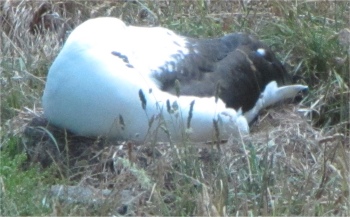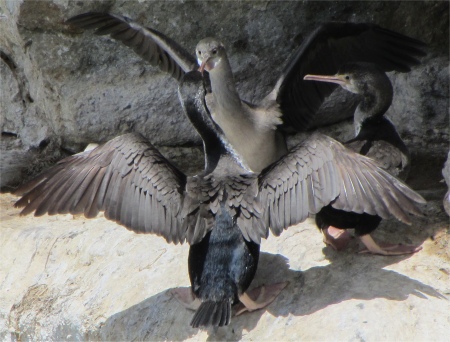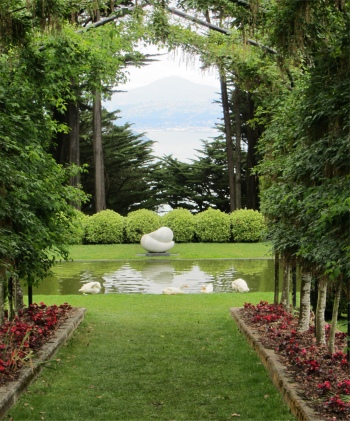 Looking Down Stuart Street to Dunedin and Otago Peninsula Beyond |
Across the crystal clear waters I recognised Dunedin at the head of the harbour, which from this side of the harbour appeared to be a pebble-dash of white buildings spread up the steep slopes and beyond.
 Dunedin Across Otago Harbour - Notice the Green Belt |
Thus I descended from whence I came, drove through the village of Portobello and as far as I could get along the peninsula, Taiaroa Head (Pukekura), where cold waters reared up from the continental shelf, providing a rich and constant supply of food. This was home to the Royal Albatross Centre, the only mainland colony of albatrosses in the world. Taiaroa has served as a defensive position from the beginning of human occupation around 700 years ago. Maori established a permanent settlement at Otakou on the coast 6km south, and a fortified village (pa) was built at Taiaroa Head.
 Stewart Island Shags and Their Nests |
 Sleeping Royal Albatross |
The stench of rotten fish sent my nostrils twitching as I climbed out of my waggon. I was to learn that birds such as Shag don't tidy up after themselves when they drop bits of fish. I joined the obligatory tour, our German guide gave a short presentation, and then we promptly trooped up a winding path towards the top of the head to a hide. Albatrosses don't go in for flapping their wings and flying, they like a strong wind into which they can spread their enormous 3m wingspan (they are second in size to the wandering albatross), step off a slope and just soar into the air. Today we had of course a slight breeze, so no flying displays from the Royal Albatross.
 Red-billed Gulls and Their Chicks |
The egg is very large, and it takes on average 3 days for the chick to emerge from the shell. During March, the guard stage, parents take turns feeding and sitting on the chick for the first 30-40 days. From April to July, the chicks are left on their own, and the parents return separately to feed them every 2-4 days.
In August, the chicks start to become active and walk around. Feeding is then less frequent. Then come September, the chicks flee the nest, and are gone for 4-6 years on average, staying out at sea for the whole duration.
 Spotted Shag Feeding Time |
These monarchs of the skies hadn't always lived here. There is a theory that their primary colonies on the Chatham Islands became overcrowded, and Taiaroa Head became an overspill site. The first egg was laid here in 1920, and the first chick fledged successfully in 1938. Since then the colony has grown slowly to a population of around 150 now.
Far below the slumbering albatross were gathered a noisy bunch of Stewart Island Shags. They were having the Shag equivalent of Prime Minister's Question Time, and boy were they gesticulating. An area slightly above them looked like a miniaturised lunar landscape, complete with dozens of craters. These craters were the nests of the Shags, made out of a mixture of mud, seaweed and bird droppings.
At the very bottom of the cliff, fur seals played amongst the Bull Kelp. The channel here across the mouth of Otago Harbour was very narrow; I would have loved to have seen one of the large cruise ships negotiate its way through the tricky opening. Large ships could only get as far up the harbour as Port Chalmers, beyond which the channel became narrow and shallow.
 Larnach Castle |
 Larnach Castle Grounds |
William Larnach, an Australian, was a successful banker and politician. He built the castle, New Zealand's only castle, though it is more of a chateau than a castle, for his beloved first wife, Eliza Jane Guise, a descendant of French nobility. Construction began in 1871, and 200 workmen laboured for three years before the family moved in. Gifted European craftsmen worked for twelve more years to embellish the interior with the finest materials from around the world, which arrived at Port Chalmers, and were then punted across the harbour and hauled uphill by ox-drawn sleds. The building was completed with the addition of the splendid ballroom in 1887, Larnach's 21st birthday gift to his daughter, Katie.

